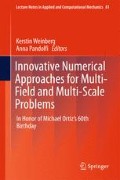Abstract
The material-point method (MPM) was introduced about 20 years ago and is a versatile method for solving problems in continuum mechanics. The flexibility of the method is achieved by combining two discretizations of the material. One is a Lagrangian description based on representing the continuum by a set of material points that are followed throughout the calculation. The second is a background grid that is used to solve the continuum equations efficiently. In its original form, some applications of the method appeared to be second order accurate while other tests showed poor or no convergence. This paper provides a framework for analyzing the errors in MPM. Moreover, the analysis suggests modifications to the algorithm to improve accuracy. The analysis also points to connections between MPM and other meshfree methods.
Access this chapter
Tax calculation will be finalised at checkout
Purchases are for personal use only
References
Arroyo, M., & Ortiz, M. (2006). Local maximum-entropy approximation schemes: A seamless bridge between finite elements and meshfree methods. International Journal for Numerical Methods in Engineering, 65(13), 2167–2202.
Atluri, S. N., & Zhu, T. (1998). A new meshless local Petrov-Galerkin (MLPG) approach in computational mechanics. Computational Mechanics, 22, 117–127.
Beltschko, T., Lu, Y. Y., & Gu, L. (1994). Element-free Galerkin methods. International Journal of Numerical Methods in Engineering, 37, 229–256.
Belytschko, T., Krongauz, Y., Organ, D., Fleming, M., & Krysl, P. (1996). Meshless methods: An overview and recent developments. Computer Methods in Applied Mechanics and Engineering, 139, 3–47.
Brackbill, J. U. (1988). The ringing instability in particle-in-cell calculations of low-speed flow. Journal of Computational Physics, 75, 469–492.
Brackbill, J. U., & Ruppel, H. M. (1986). FLIP: A method for adaptively zoned, particle-in-cell calculations of fluid flows in two dimensions. Journal of Computational Physics, 65, 314–343.
Duan, Q., Gao, X., Wang, B., Li, X., Zhang, H., Belytschko, T., et al. (2014). Consistent element-free Galerkin method. International Journal for Numerical Methods in Engineering, 99, 79–101.
Duarte, A. C., & Oden, J. T. (1996). H-p clouds–an h-p meshless method. Numerical Methods for Partial Differential Equations, 12(6), 673–705.
Han, W., & Meng, X. (2001). Error analysis of the reproducing kernel particle method. Computer Methods in Applied Mechanics and Engineering, 190, 6157–6181.
Harlow, F. H. (1957). Hydrodynamic problems involving large fluid distortions. Journal of the Association for Computing Machinery, 4, 137.
Li, S., & Liu, W. K. (2002). Meshfree and particle methods and their applications. Applied Mechanics Reviews, 55(1), 1–34.
Li, B., Habbal, F., & Ortiz, M. (2010). Optimal transportation meshfree approximation schemes for fluid and plastic flows. International Journal for Numerical Methods in Engineering, 83, 1541–1579.
Liu, W., Jun, S., Li, S., Adee, J., & Beltschko, T. (1995). Reproducing kernel particle methods for structural dynamics. International Journal of Numerical Methods in Engineering, 38, 1655–1680.
Liu, W. K., Jun, S., & Zhang, Y. (1995). Reproducing kernel particle methods. International Journal for Numerical Methods in Engineering, 20, 1081–1106.
Melenk, J. M., & Babuska, I. (1996). Partition of unity finite element method. Computer Methods in Applied Mechanics and Engineering, 139, 314–389.
Nguyen, V. P., Rabczuk, T., Bordas, S., & Duflot, M. (2008). Meshless methods: A review and computer implementation aspects. Mathematics and Computers in Simulation, 79(3), 793.
Shepard, D. (1968). A two-dimensional interpolation function for irregularly-spaced data. In Proceedings—1968 ACM National Conference (pp. 517–524).
Steffen, M., Kirby, R. M., & Berzins, M. (2008). Analysis and reduction of quadrature errors in the material point method (MPM). International Journal for Numerical Methods in Engineering, 76(6), 922–948.
Steffen, M., Kirby, R. M., & Berzins, M. (2010). Decoupling and balancing of space and time errors in the material point method (MPM). International Journal for Numerical Methods in Engineering, 82, 1207–1243.
Sulsky, D., Chen, Z., & Schreyer, H. L. (1995). Application of a particle-in-cell method to solid mechanics. Computer Physics Communications, 87, 236–252.
Acknowledgments
This work was partially supported by the National Science Foundation under grant ARC 1023667 to the University of New Mexico.
Author information
Authors and Affiliations
Corresponding author
Editor information
Editors and Affiliations
Rights and permissions
Copyright information
© 2016 Springer International Publishing Switzerland
About this chapter
Cite this chapter
Sulsky, D., Gong, M. (2016). Improving the Material-Point Method. In: Weinberg, K., Pandolfi, A. (eds) Innovative Numerical Approaches for Multi-Field and Multi-Scale Problems. Lecture Notes in Applied and Computational Mechanics, vol 81. Springer, Cham. https://doi.org/10.1007/978-3-319-39022-2_10
Download citation
DOI: https://doi.org/10.1007/978-3-319-39022-2_10
Published:
Publisher Name: Springer, Cham
Print ISBN: 978-3-319-39021-5
Online ISBN: 978-3-319-39022-2
eBook Packages: EngineeringEngineering (R0)

